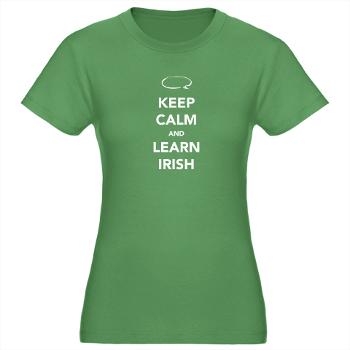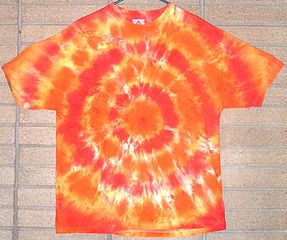Léinte, T-Léinte agus T-Léinte Snaidhmruaimnithe (and a few other types of shirts as well) Posted by róislín on Apr 30, 2014 in Irish Language
(le Róislín)

Seo t-léine atá ag siopa Cafe Press de chuid Transparent Language. Ceann luiteach (do mhná) atá sa phictiúr seo. Tá an ghnáthstíl (d’fhir agus do mhná) ann freisin.
You may have seen the recent notice for Transparent Language’s t-shirt store, which includes the popular slogan “Keep Calm and Learn Irish.”
Ever wonder how the word “t-shirt” evolved in English, and, even more to the point, how to say “t-shirt” in Irish? Fiosrach? Léigh leat!
First, an Béarla, since the shirt’s origins are generally considered American. The design is over 100 years old now. The version closest to today’s tees was originally issued by the U.S. Navy as an “undershirt” (léine chnis, lit. skin/body-shirt, i.e. shirt worn next to the skin or body, from léine, shirt, and cneas, skin, body). The first models were white (bán), cotton (cadás, with “cadáis” for “of cotton”), and crew-neck (muineál criú); they were sometimes known as “gob shirts.” The popular name “t-shirt” comes from the shirt’s shape and the word started appearing in English dictionaries in the 1920s.
There are some possible predecessors (réamhtheachtaithe) but they don’t sound exactly like today’s cotton t-shirts (t-léinte cadáis an lae inniu). One concerns the British Royal Navy in the 1850s, with sailors quickly sewing sleeves (muinchillí) onto their woolen sleeveless undershirts when Queen Victoria (An Bhanríon Victoria) surprised them with a visit. The newly attached sleeves meant that she wouldn’t have to see the men’s hairy armpits (ascaillí fionnaitheacha na bhfear). Even if this account is true, the shirts were apparently made of wool (déanta d’olann), not cotton (cadás). Another contender is from Kentucky, with the Union Underwear Company separating the traditional wool one-piece “union suit” into separate shirts and bottoms. Some sources say this also was in the 1850s, but others say that this company wasn’t established until 1926. So I’d take both explanations with a grain/pinch of salt (gráinnín salainn).
In the 1930s, the University of Southern California football team issued similar shirts to be worn under the players’ uniforms (faoi éidí na n-imreoirí) to prevent chafing (scríobadh). The rest, we can safely say, is “stair” (history).
And here’s a little t-shirt history quiz, i nGaeilge, ar ndóigh (freagraí thíos):
1) Cad é an scannán is mó inar thaispeáin Marlon Brando a “mhaighnéadas ainmhí” agus t-léine bhán á caitheamh aige? (Leid: scannán ó na 1950í atá i gceist–ní hé “An tAthair Baistí” é).
2) Cén luach atá ar an t-léine nua is daoire ar domhan (luach ar 26 Meitheamh 2013)?
3) Ar ábhar na scannán, cé hé an t-aisteoir Meiriceánach eile óna 1950í a raibh cuma chúláilte air agus t-léine á caitheamh aige?
4) Cén ruaim a d’úsáid a lán daoine, go mór mór “hipithe,” chun t-léinte snaidhmruaimnithe a dhéanamh ag deireadh na 1960í agus tríd na 1970í?
And now for “t-shirt” terminology i nGaeilge, starting with the basic word for “shirt,” which also means “tunic.” “Léine” can refer to the knee-length tunic worn by the “seanGhaeil,” but mostly today it is understood as a standard-length shirt. Today, “tuineach” is usually used for “tunic.” Here are “shirt” and “shirts”:
léine, a shirt
an léine, the shirt
na léine, of the shirt; dath na léine
And for the plural:
léinte, shirts
na léinte, the shirts, with the same form for “of the shirts”; dathanna na léinte
As for the word “t-shirt,” the earliest I see it in Irish dictionaries (based on a quick check of online and hard copy sources) is the 1980s, not too surprising, I suppose. If anyone finds an earlier reference (tagairt) to “t-léinte,” either as a vocabulary word or in a literary context, or better yet, an Irish-language clothing catalog, I’m sure our readers would be interested. The earliest tagairt I find to the word is from 1981 in Buntús Foclóra: A Children’s Irish Picture Dictionary, which has “Breis agus 1000 focal agus pictiúir ildaite” and is a great colorful resource for Irish learners, young and old. Use of the word “t-léine” may have been kickstarted here because the layout of the book is a template filled in for many languages. Including “t-shirt” was probably a foregone conclusion for the English version of the dictionary, and other languages followed, umm, suit.
I’m sure I’ve also heard “léine-T” from time to time, but I don’t see it listed as such in any Irish dictionaries or glossaries.
Here are the forms for “t-shirt” in Irish:
t-léine, t-shirt
an t-léine, the t-shirt; an t-léine shnaidhmruaimnithe (the tie-dyed t-shirt)
na t-léine, of the t-shirt; praghas na t-léine snaidhmruaimnithe (the price of the tie-dyed t-shirt)
t-léinte, t-shirts; t-léinte snaidhmruaimnithe (tie-dyed t-shirts)
na t-léinte, the t-shirts; na t-léinte snaidhmruaimnithe (the tie-dyed t-shirts)
na t-léinte snaidhmruaimnithe, of the tie-dyed t-shirts; praghasanna na t-léinte snaidhmruaimnithe (the prices of the tie-dyed t-shirts)
In case you’re wondering about the rather consonant-laden word “snaidhmruaimnithe” (love that -dhmr” combo!), it actually breaks down quite nicely:
snaidhm [rhymes with English “time” or “team,” depending on dialect], a knot; this word is the basis for the place name “Sneem” in Co. Kerry (“An tSnaidhm” i nGaeilge)
ruaim [ROO-im], a dye, originally and sometimes still, specifically a red dye
ruaimniú, dyeing, to dye, originally and sometimes still, “to dye red.” We can add a suffix (-the) to the root of this word to create the adjective form: ruaimnithe (dyed; sometimes, but not usually, in my experience, “dyed red”).
Voilà! We have “snaidhmruaimnithe” [SNAIM-ROO-im-nih-huh, with the “ai” as in the IPA designation /ai/ as in English “time” or “slime”]. Only two consonants are actually silent, the “d” and the “t.”
And one last change that will kick in after feminine singular nouns like “t-léine“:
shnaidhmruaimnithe [HNAIM-ROO-im-nih-huh]
The initial “s” has changed to “sh” and the pronunciation changes accordingly.
So, in conclusion, we have:
t-léine
t-léine shnaidhmruaimnithe
t-léinte snaidhmruaimnithe
And, of course, there are simpler ways to describe t-léinte, such as:
t-léine bhán; t-léinte bána
t-léine mhór; t-léinte móra
As for the English shorthand “tees,” when referring to “t-shirts,” I don’t really see any equivalent in Irish. I suppose if you wanted to, you could say “t-anna,” but that would normally be interpreted as referring to the letter “t” itself, as in “Tá a lán t-anna i sloinne Andy Pettitte, caiteoir na Yankees.”
And finally, a few other non-T shirt phrases (pertaining to shirts in general) :
bóna léine, a shirt collar (as opposed to “coiléar,” for dogs)
léine Aifrinn, a surplice, lit, a Mass shirt/tunic
léine mháilleach, a mail shirt
léine róin, a hair-shirt or cilice, worn for atonement or repentance (from “rón,” horsehair, not “rón,” a seal)
Bhuel, sin é don bhlag seo. Aisteoirí clúiteacha, caiteoir clúiteach, t-léinte, an focal “t-léine” é féin, agus cúpla dóigh le cur síos ar t-léinte agus an focal deas fada “snaidhmruaimnithe” ina measc. And whatever kind of t-léine you may sport, “Trog gezunterhait,” mar a deir siad sa Ghiúdais, and for which a close Irish equivalent would be “Go maire tú é.” Puzzled by that? Féach an nóta thíos. SGF — Róislín
Freagraí
1) Tram Darb Ainm “Cíocras”, 1951 (le Tennessee Williams)
2) SAM $400,000 (tá naoi ndiamant ar an t-léine seo)
3) James Dean sa scannán Reibiliúnach gan Chúis (1955)
4) RIT, i Meiriceá, ar a laghad
Nóta faoi “Go maire tú é” This is translated as “Well may you wear it” in Buntús Cainte and elsewhere, but literally it means “May you live (to wear) it.” A pleasant sentiment but also a reminder of our “mortlaíocht.”
Naisc do na pictiúir:
http://www.cafepress.com/transparentlanguage
http://en.wikipedia.org/wiki/File:TieDyeShirtMpegMan.jpg; A tie dyed shirt. Photo by MpegMan. ({{GFDL}})
Webliography:
http://www.neatorama.com/2011/03/17/a-brief-and-incomplete-timeline-of-t-shirt-history/#!KqOVW (17 Márta 2011)
http://www.founditemclothing.com/itgoesto11/most-expensive-t-shirt-in-the-world-priced-at-400000/ (26 Meitheamh 2013)
http://www.uticacustomtshirt.com/History_of_the_T-Shirt.html (gan dáta)

Build vocabulary, practice pronunciation, and more with Transparent Language Online. Available anytime, anywhere, on any device.





Leave a comment: